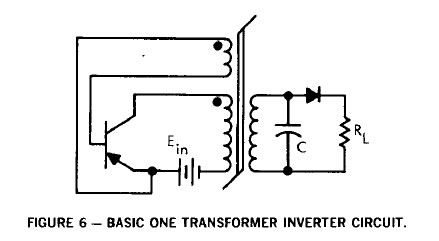The physics of inverter circuits is a very complicated subject. As the materials or these circuits can vary widely, the fudamental equations for these circuits can differ tremendously.
Typically seen applications of these devices are generally small wattage with very little smoothing circuitry involved to the "squaring effect" inherent in the nature of DC to AC conversion.
Seen in many inverter applications, is the presence of what is known as a modified sine wave voltage. These have a slightly squared off current, but follows a near sinusodal pattern. Some extremely senstive electronic are still, however, effected.
Here is the circuit diagram for one of the most simple inverter circuits, used fairly often, in basic electronics:

This circuit would be used in a low power situation. The switching that has to happen occurs when the transformer core becomes saturated, the oscilator switches positions, then becoming reset by the power in the capictor in the circuit. This then allows the switch in polarity making it an AC current.